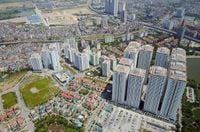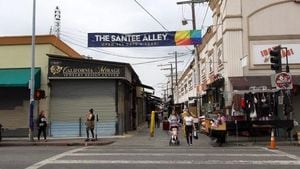Hanoi is undergoing a significant administrative reorganization, with plans to establish 125 new wards and communes, a move approved by the Hanoi City Council. This restructuring aims to optimize management efficiency and enhance urban planning. However, the new Hong Ha ward remains without a designated headquarters, posing a challenge for local governance.
The newly formed Yen So ward will merge the majority of the existing Yen So ward in Hoang Mai district, along with parts of Thinh Liet, Hoang Liet, and Tran Phu wards, as well as sections of Tu Hiep commune and Van Dien town from Thanh Tri district. To facilitate operations, the city plans to temporarily locate the ward's agencies in student dormitories within the Phap Van - Tu Hiep urban area.
The Phap Van - Tu Hiep dormitory complex spans 40,000 square meters and includes six blocks, averaging 17 floors each. However, only three buildings—A1, A5, and A6—have been completed, while construction on A4 has stalled due to space issues, and A2 and A3 remain unfinished. In 2017, the Department of Construction suggested converting A2 and A3 into social housing, but funding for this initiative is only set to be allocated in 2024.
Similarly, the new Dai Mo ward will be formed by merging most of the Dai Mo and Trung Van wards, along with portions of Phu Do, Me Tri, Mo Lao, Duong Noi, Trung Hoa, and Nhan Chinh wards. The Trung Van commercial center is anticipated to serve as the headquarters for the new ward's administrative agencies, as the existing facilities are insufficient to accommodate the expanded governance structure.
The Trung Van commercial service center, completed in 2012, consists of two two-story buildings covering over 17,000 square meters and is currently leased to various businesses for commercial use.
Among the 126 new wards and communes being established, Hong Ha ward is the only one without a proposed headquarters. This ward is formed by consolidating the entire area and population of Phuc Tan and Chuong Duong wards in Hoan Kiem district, as well as Phuc Xa in Ba Dinh district. It also includes significant portions of Nhat Tan, Tu Lien, and Yen Phu wards in Tay Ho district, and parts of Thanh Luong and Bach Dang in Hai Ba Trung district. The absence of a proposed headquarters location for Hong Ha has raised concerns, as the ward encompasses a vast residential area along the Red River, spanning five districts.
In total, the administrative units at the commune level in Hanoi will decrease from 526 to 126, comprising 50 wards and 76 communes. This reorganization is not merely a change of boundaries but a strategic move to streamline governance and enhance local services.
The city is actively reviewing the utilization of headquarters across 30 districts and 526 wards before the reorganization takes effect. The goal is to prioritize the establishment of administrative offices in central locations with accessible socio-economic infrastructure, particularly focusing on transportation connections to the community.
In a broader context, the planning for Hoang Mai district is also being adjusted in light of the administrative changes. Established in 2004, Hoang Mai district covers an area of 41 square kilometers and ranks fourth in size among Hanoi's districts. Following the reorganization, the number of wards in Hoang Mai has been reduced from 14 to 7, facilitating improved management and urban development.
The new wards in Hoang Mai include Hoang Mai, Vinh Hung, Tuong Mai, Dinh Cong, Hoang Liet, Yen So, and Linh Nam, with populations ranging from approximately 36,000 to over 88,000 residents. This reduction aims to simplify the administrative apparatus while fostering coherent urban planning.
Hoang Mai district's strategic location, bordering Gia Lam and Long Bien districts to the east, Thanh Tri to the west and south, and Hai Ba Trung and Thanh Xuan to the north, enhances its connectivity. Key transport routes such as National Highway 1 and Ring Road 3 traverse the area, positioning it as a vital hub for economic and urban development.
As part of the development strategy, local authorities are focusing on upgrading transport infrastructure, attracting investment in housing projects, and promoting socio-economic growth. The district is poised to become one of the dynamic development areas in Hanoi, with plans for modern urban areas and improved living conditions.
The overall urban planning for Hoang Mai district extends until 2030, with a vision toward 2050. The district is earmarked as a significant component of Hanoi's urban expansion strategy, emphasizing modern urban, industrial, and service development.
Key planned projects include the Thinh Liet new urban area, the Dai Kim new urban area, and the expansive Yen So lakeside urban area. These developments aim to create a vibrant living environment while accommodating a growing population.
In recent years, the real estate market in Hoang Mai district has experienced remarkable growth, driven by clear planning policies and significant infrastructure improvements. From 2024 to early 2025, property prices surged, particularly in the apartment sector, with older units seeing substantial price increases.
For instance, prices for older apartments in the HH Linh Dam project have risen from 13.5-15.5 million VND per square meter in 2015-2017 to 37-43 million VND per square meter in 2025. New developments like Hanoi Melody Residences are entering the market with competitive pricing, further stimulating interest from investors and homebuyers alike.
While the opportunities for investment in Hoang Mai district are promising, potential investors must remain vigilant regarding the challenges that accompany rapid growth. The rising property prices may create supply-demand fluctuations, and legal issues related to land and project approvals could pose risks.
As Hanoi continues to evolve, the administrative reorganization and the strategic planning of districts like Hoang Mai are set to shape the city's future significantly, paving the way for enhanced living standards and economic vitality.




